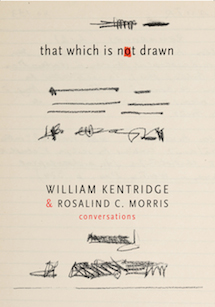By Svetlana Alpers
If you have seen some of his work or have perhaps have only heard of the South African artist William Kentridge, this fine, small book offers the perfect introduction. The text is dense. The notes at the end take the form of well selected illustrations noted by red asterisks as you read along.
The book is strikingly designed as all Seagull books are. This one is by Sunandini Banerjee with incidental marks by Kentridge himself. It is an extension of this artist’s habit of printing his own drawings on pages taken from old books.
As in a number of previous publications, Kentridge is presented here in conversation. He is an inquiring man with a playful mind which matches the playful practice of his art. This time he is in Calcutta talking with an anthropologist from Columbia University.
Kentridge is one of the leading international (must one now say transnational?) artists of our time—a draughtsman, printer, and film-maker who also designs tapestries and sculpture and has put plays and operas (and soon Schubert’s Die Winterreise) on stage. An interest of the book is that in giving one a sense of his temperament and taste in the making of art, it also gives one a new sense of the nature of our time.
First, things political. Born in post-colonial apartheid South Africa into a Jewish family with Lithuanian origins—strife and mixture or, as he provocatively calls it, the virtues of bastardy are in the nature of his experience. This is the grounding for his magnificent staging of Shostakovitch’s The Nose (Leningrad, 1928). The questions and concerns raised by the Russian revolution also arise in South African politics. What particularly interests Kentridge is the relationship between a creative utopian idealism in politics and art and how it can go drastically wrong. Out of that has come his commitment to uncertainty as the alternative to authoritarian rule. The general point that I am getting more convinced of is the calamity that comes with political certainty aligned with a monopoly on violence.
So, from politics to practice. Kentridge has made uncertainty the basis of his particular drawing and filmic practice. He invented a form of animation based on the drawing, erasure, redrawing, and photographing of what become successive images or frames. Provisionality is at the heart of such making. And that extends to the look of the images in which, for example, a coffee pot with a plunger can metamorphose into a drill bit running down into a South African mine, or a cat can turn into a phone or a bomb.
It is important to note, as Kentridge does himself, that one thing he is not is a painter. Indeed, as he also says, he does not work in any single medium as such. That is the rejection of another form of authority. And with that goes a rejection of the certainty that the painter or traditional draughtsman tries to capture in an image. The aim of discovering and so knowing the individuality of a person or of an object is replaced by motion, change, and continuities over time.
The aim to capture or discover a person or an object has long been an aim of artists even if it necessarily ends in a failure only to be tried again. Think, for example, of Cézanne. Magical though it is to watch Kentridge films, one thing that has also been put aside is that human sense of loss. Loss is lost.
The conversations in the book circle around and around linking Kentridge’s ideas and his ways of making. The general topic is the spoken and the hidden, or as the title has it, what he has not yet drawn. A wonderful example of that comes right at the end. Kentridge retells the tale of a sultan captured in the Crusades and brought back to France to be held as a prisoner for twenty years. Kentridge imagines the number of years as like being trapped within a book—wherever you open the book the sultan would be there sleeping, walking, spending time marking the wall. . . The book as prison. It is a subject for a drawing yet to be made.
At the heart of the matter are the distinctions that make his art an art for and of our time: moving images rather than still, metamorphoses instead of individuals, continuity not loss.
Svetlana Alpers, an artist, critic and renowned art historian, is professor emerita of the history of art at the University of California, Berkeley and a visiting scholar in the Department of Fine Arts at New York University.




